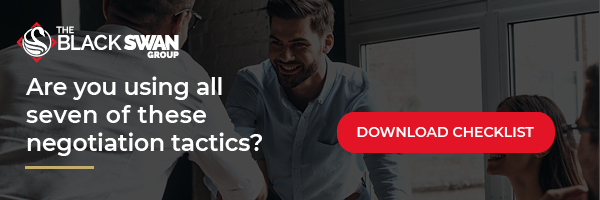Tactical Empathy® is all about understanding the other side. It doesn’t mean you feel how they feel—just that you can gain valuable information so you see things how they do, particularly when you don’t agree with them.
Some of the most difficult conversations any of us encounter—whether in our personal or professional lives—happen with people or in circumstances we don’t agree with. In these scenarios, many of us are uncomfortable; it’s not uncommon to be offended by someone else’s position, and that’s perfectly OK.
At its core, Tactical Empathy is not sympathy or regular empathy. It’s not common ground. To execute Tactical Empathy, you need to understand your counterpart’s point of view and the depth behind it and ensure they feel heard. Otherwise, they won’t listen to what you have to say.
Tactical Empathy® expedites trust-building.
Because Tactical Empathy helps counterparts feel understood, it expedites trust-building, making it an ideal tool that serves as the foundation for healthy long-term relationships. That being the case, Tactical Empathy is something we should all use in personal relationships and with our teams.
When you lead with Tactical Empathy, you begin working collaboratively toward solutions. In business, this enables you to become a trusted advisor. When you have to share difficult news, the people you work with will be more comfortable because Tactical Empathy makes them feel that their needs and emotions are understood. As a result, their autonomy is protected even when the situation throws them a curveball.
Of course, this doesn’t mean that everything will work out for them how they want; quite the contrary. Instead, they feel they’ve been given the opportunity to engage in a way that allows them to be heard. Because most of us are so used to trying to get our counterparts to hear us, the opportunity to be truly heard provides a major release.
Tactical Empathy helps you learn more information.
In sales, many people often do everything they can to get their counterparts to say yes and listen to them. In this pursuit, they miss valuable information because they make the conversation about themselves.
By taking the time to use Tactical Empathy, you can bypass hurdles in a negotiation.
Kick off the conversation with Accusation Audits® to identify and defuse your counterpart’s concerns and fears. Make sure you listen at a higher degree and apply Dynamic Silence™ to give your counterpart space to think and speak. By staying curious and figuring out what makes your counterpart tick, you can understand them on a deeper level, making it that much easier to achieve the outcomes you’re aiming for.
And don’t forget to use Summaries™! When you summarize what the other side just told you, you can gain clarity and ensure you understand what they said without sounding like you’re accusing them of anything. You relay what you think you heard or how it makes you feel; if you’re wrong, your counterpart will correct you because the desire to correct is irresistible.
Tactical Empathy works on people of all ages.
Tactical Empathy works as well with an eight-year-old as it does with a 17-year-old or an 85-year-old.
Everyone with kids knows what it’s like to ask them a question when they come home from school: How was school today? The response: It was fine. The follow-up question: What did you do? The response: Nothing.
If you use Tactical Empathy instead, you might say something like this: It seems like you had a great day at school today, or It sounds like you enjoy being around your friends. Kids get defensive when asked direct questions; using Labels™ will open the floodgates of truth talk.
If you’re new to the game-changing promise of Tactical Empathy, start using Black Swan skills at coffee shops, restaurants, and grocery stores with the simple goal of learning more about the people you’re interacting with.
By doing so, you put in the reps and get comfortable with the skills. The more comfortable you are using the skills in your daily life, the easier it will be to put them to use when the stakes are highest.
To continue learning, check out The Ultimate Negotiation Checklist for Sales Teams to ensure you’re prepared next time you sit down at the table.


